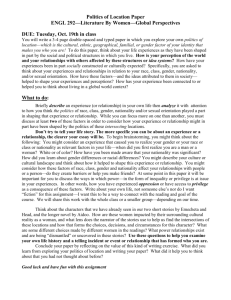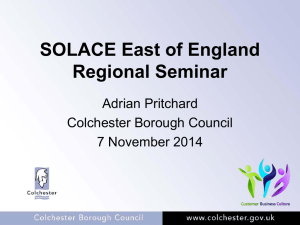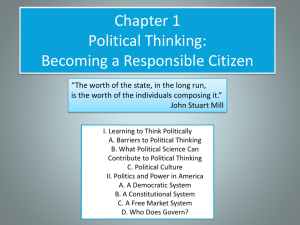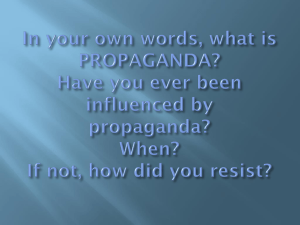to access the Online Appendix - New Research on Gender in
advertisement
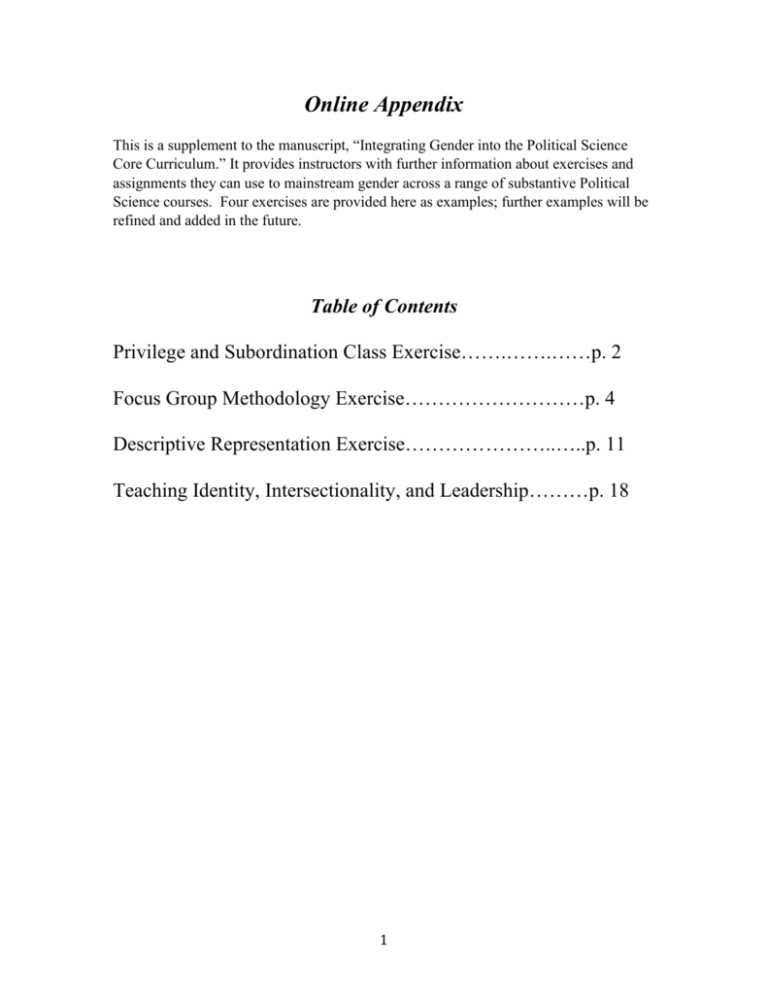
Online Appendix This is a supplement to the manuscript, “Integrating Gender into the Political Science Core Curriculum.” It provides instructors with further information about exercises and assignments they can use to mainstream gender across a range of substantive Political Science courses. Four exercises are provided here as examples; further examples will be refined and added in the future. Table of Contents Privilege and Subordination Class Exercise…….…….……p. 2 Focus Group Methodology Exercise………………………p. 4 Descriptive Representation Exercise…………………..…..p. 11 Teaching Identity, Intersectionality, and Leadership………p. 18 1 Privilege and Subordination Class Exercise Possible Course/s for Use: Political Psychology Class Size and Level: Used in a large lecture course with 50-100 students Creator: Lauren Duncan, Smith College, Department of Psychology (lduncan@smith.edu) Resource Provided: Overview, step-by-step instructions for an instructor to conduct the exercise (including the web link to assigned reading) and a sample “Who Am I” worksheet to accompany the exercise Student Learning Goals: 1. Discuss dominant and subordinate group memberships, group status, prejudice, and dominant group privilege. 2. Recognize that everyone is privileged in some ways and disadvantaged in others, and reduced resistance to discussing politically charged topics like inequality. Resources: Overview This exercise works well for starting discussions of dominant and subordinate group membership and effects on status. It complements discussions of prejudice by focusing on the privilege of dominant groups. Instructions 1. Students read Peggy McIntosh’s piece, “White Privilege: Unpacking the Invisible Knapsack” (www.nymbp.org/reference/WhitePrivilege.pdf) prior to class. 2. Students fill out a “Who am I” worksheet as they come into class (see below). Students typically write in personality descriptors, group memberships, and roles. 3. Discuss what the students wrote. Introduce these categories, and ask students which categories their top 3-5 descriptors fit into. Discuss the fact that people often list characteristics that are most salient to them in a particular situation. Mention that everyone has some group memberships that are privileged, and most have some group memberships that are not. 4. McIntosh’s article deconstructs oppression. Explain that, when we deconstruct something, we look for what’s missing. In the case of racial oppression, what’s missing is racial privilege—they are two sides of the same coin. In this exercise we look more at the flip side of oppression—privilege. Have students call out other group memberships in which there are dominant and subordinate groups (e.g., gender, race, ethnicity, sexual orientation, gender presentation, social class, education, religion, ability/disability, etc.). 5. Write them on the board. 2 6. Have students choose one group membership that they want to use to create a series of 10 statements like McIntosh’s about invisible privilege. Break them into groups of about 4 and have them work on the statements. 7. After about 20 minutes, have each group come to the front of the class to share their statements. If there are multiple groups doing the same group membership, do them in succession. Who Am I? 1. _________________________________________________________________ 2. _________________________________________________________________ 3. _________________________________________________________________ 4. ________________________________________________________________ 5. _________________________________________________________________ 6. _________________________________________________________________ 7. ________________________________________________________________ 8. ________________________________________________________________ 9. _________________________________________________________________ 10. _________________________________________________________________ 3 Focus Group Methodology Exercise Possible Course/s for Use: Research Methods Class Size and Level: Any size course, sophomore level and beyond Creator: Erin Cassese, West Virginia University, Department of Political Science Resource Provided: Exercise overview and Powerpoint slides Student Learning Goals: 1. Learn how to conduct focus groups and analyze data obtained via this method 2. Consider and discuss how gender composition and gender dynamics affect focus group and research findings more broadly Resources: Overview The objective of the student focus group organizers is to determine if the participants think about politics in ideological terms and to gauge their level of political sophistication. Of course, the exercise could be adapted to address any question relevant to the study of public opinion. The three focus groups employed varied in their gender composition such that they were composed of all male students, all female students, and a mix of male and female students. After covering the substantive responses of the group members, the instructor asks the students to discuss how the gender of the participants influenced the kinds of answers they provided. In addition, the students analyzed the ways in which the gender balance of the groups affected their dynamics. This discussion was linked to previous weeks’ lessons on large-n surveys and interviewer effects. While not the focal point of the exercise, the inclusion of gender as a potential confound creates a highly visible avenue for students to critically assess the kinds of factors might affect the validity of data obtained this way. 4 Powerpoint Slides 5 6 7 8 9 10 Descriptive Representation Exercise Possible Course/s for Use: Public Opinion, Introduction to U.S. Politics, U.S. Congress Class Size and Level: Used in introductory and upper-level classes of 25-30 students Creator: Angela Bos, College of Wooster, abos@wooster.edu Resources Provided: Overview, lecture excerpt and Powerpoint slides Student Learning Goals: 1. Learn concepts related to group representation in politics (descriptive and substantive representation) 2. Critically reflect on which groups need political representation based on specific criterion Resources: Overview This exercise works well to introduce gender in relation to descriptive representation. This is an interactive lecture and small group activity discussion that gets students to critically examine whether women (or other groups) need to be descriptively represented in politics. The basic idea is to list many groups on the board (e.g., redheads, farmers, gay men, women) and ask students to work in small groups to generate ideas about which groups most and least need political representation. Then, as part of the discussion, students are asked to evaluate group needs for political representation based on criterion laid out in Sapiro’s (1981) essay. The piece lays out four specific criterion which indicate a group needs political representation, including: 1) having unique, politically relevant characteristics, 2) having special interests, 3) sharing particular social, economic, or political problems and 4) sharing distinct viewpoints re: solutions to shared problems. Assigned Reading: Sapiro, Virginia. 1981. When are Interests Interesting? The Problem of Political Representation of Women. American Political Science Review 75(3): 701-716. Lecture Excerpt Ask students to think on their own, then pair with a partner, and then share with the class (think-pair-share). They will be brainstorming. Give students a list of characteristics/group identities like: o Gay men, Asian Americans, scientists, blonds, women, foreign-born US citizens, cancer survivors, Midwestern farmers, and the elderly. o THEN ASK THEM: What characteristics in this list are important politically and should be represented politically? Why did you choose these? What makes them politically relevant? 11 Say: You selected gender - - lets discuss that more. Historically: women represented by their husbands and males the only politically relevant members of society. But we could argue whether women have the same political positions and same interests as their husbands! ASK STUDENTS: What are the public and private spheres discussed in the readings? Women associated with private sphere historically (still do more in private sphere on most measures like housework, child rearing, etc.) and only later emerged in public sphere. o Women seen as lacking capacity for politics, as too emotional for it, etc. Changes in government/society led to women gaining full political rights (e.g., to participate in government). Practically, we might conclude based on this that the problem of women and political representation is solved! But, probably not! One major question to pursue (Raised in a thoughtful essay by Virginia Sapiro) – her most interesting question is: 1. On what grounds can we argue that women-as a group- need political representation? Are women a politically relevant group deserving of representation of their interests? We know there is a discrepancy between the percentage of women in office and in society What, if anything, makes gender a politically relevant consideration? Why is gender politically important, but not hair color, for example? ***ASK STUDETNS: What would indicate women must be politically represented? [BRAINSTORM AS A CLASS – AND THEN PUT UP INFORMATION ON THE SLIDE] Women as a group: (p. 703 in Sapiro’s article) 1) Have unique politically relevant characteristics 2) Have special interests to which representatives should respond e.g., women’s issues: experiences lead to these interests, more interested than men, different viewpoints on these issues. 3) Share particular social, economic, or political problems 4) Share distinct (from men) viewpoints regarding solutions to shared problems Keep the slide up and ASK STUDENTS: to what extent do you think women as a group meet these criteria? [brainstorm a list of how women meet these – or not] • Discussion. ASK STUDENTS: On this list: are there some that might not be shared by lesbians? Women of color? Women who choose not to have children? Poor women? Older women? If so, can you still think of them as being “women’s” interests? Discuss essentialism. – THIS RELATES TO: are women a monolith? Are all women liberal democrats? Women are more diverse in viewpoints than some suggest. 12 • Discussion. ASK: On your original list of politically relevant characteristics, do those group identities you selected meet these criteria? FOCUS TOGETHER ON ONE THAT CAME THROUGH IN PRIOR DISCUSSION 13 Powerpoint Slides 6/15/11 When are Interests Interesting? Women, Power and Politics Politically, what groups should be represented in the U.S.? ! ! ! ! ! Midwestern farmers Asian Americans, scientists Blondes Midwestern farmers The elderly ! ! ! ! Gay men Women Foreign-born US citizens Cancer survivors 1 14 6/15/11 What would indicate women –as a groupshould be politically represented? Women as a group: ! 1) have unique politically relevant characteristics ! 2) have special interests ! 3) share particular social, economic, or political problems ! 4) share distinct viewpoints re: solutions to shared problems Descriptive Representation ! Members of all groups should be PRESENT in decision-making bodies 2 15 6/15/11 Substantive Representation Group interests can be represented by representatives who do not “mirror” them Arguments for Desc. Rep. ! ! ! Descriptive as a means to substantive representation Evidence that women govern differently Other effects on democratic process !Efficacy, etc. 3 16 6/15/11 Against Descriptive Rep. ! ! ! ! Descriptive rep. may not guarantee that a rep. will act in the interests of his/her constituents Does it meet substantive interests of groups? Doesn’t take into account other features of representation (e.g., outcomes) Others? 4 17 Teaching Identity, Intersectionality, and Leadership Possible Course/s for Use: Campaigns and Elections, Public Opinion, Introduction to U.S. Politics, Race and Politics, Media and Politics Class Size and Level: Used in a variety of course levels and sizes Creator: Angela Bos, College of Wooster, abos@wooster.edu Resources Provided: Overview, discussion questions, and sample online resources to accompany Traister’s Big Girls Don’t Cry: The Election that Changed Everything for American Women Student Learning Goals: 1. Consider the role of identity, identity appeals, the media and intersectionality in the 2008 primary and general elections Resources: Overview Rebecca Traister’s (2010) Big Girls Don’t Cry: The Election that Changed Everything for American Women is a recent book that can encourage students to consider discuss the role of identity, identity appeals, the media, and intersectionality in the 2008 primary and general elections. Discussion Questions 1. In what ways did the Democratic candidates focus-or not- their campaigns on gender and race? Which strategies were successful and which weren’t? 2. How did women- of various generations- respond to the candidates in the Democratic primary? How did the media coverage, for example, of Hillary crying, influence women’s support? 3. What examples of sexism do you see in the media coverage of the election? 4. How did the debates surrounding the 2008 election reflect longstanding feminist debates? How did the 2008 election illustrate intersectionality and its importance in politics? 5. Do you see evidence of the double bind in Hillary’s presidential bid? (could tie to double bind reading) 6. How does Traister’s role as a journalist as well as her status as a young feminist contribute to-or detract from- our understanding of the role that group identities played in the 2008 election? 7. Based on the role of race and gender in the 2008 election – as well as the ultimate election outcome – what can we expect in future elections? Will we see viable women and minorities seeking the Presidency on a regular basis? Online Resources & Teaching Ideas 18 1. In class, show the video of Hillary “crying” and discuss it with its discussion on pages 93-106 in the book. Link: http://www.youtube.com/watch?v=6qgWH89qWks 2. Have students research and follow primary polling as well as exit polls to examine gender-, race-, and age-related trends. Particularly have them focus on lead up to NH primary and post-NH to correspond with the book section around page 100. Possible Link: http://www.cnn.com/ELECTION/2008/primaries/ 3. In class, watch and discuss the Democracy Now debate “Race and Gender in Presidential Politics” between Gloria Steinem and Melissa Harris-Lacewell. Link: http://www.democracynow.org/2008/1/14/race_and_gender_in_presidential_politi cs 4. Watch the montage of sexist media coverage of Hillary from the Women’s Media Center “Sexism Sells, But We’re Not Buying It” and discuss: Link: http://www.youtube.com/watch?v=g-IrhRSwF9U a. You could tie this in with readings about media coverage of female candidates (e.g., work by scholars such as Zoe Oxley) and popular news coverage like this article in the NY Times: http://www.nytimes.com/2008/06/13/us/politics/13women.html 19




